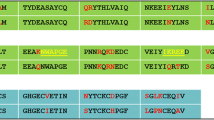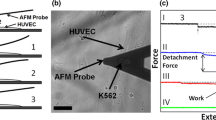Abstract
Selectin/ligand interactions initiate the multistep adhesion and signaling cascades in the recruitment of leukocytes from circulation to inflamed tissues and may also play a role in tumor metastasis. Kinetic properties of these interactions are essential determinants governing blood-borne cells' tethering to and rolling on the vessel wall. Extending our recently developed micropipette method, we have measured the kinetic rates of E-selectin/ligand interactions. Red cells coated with an E-selectin construct were allowed to bind HL-60 or Colo-205 cells bearing carbohydrate ligands. Specific adhesions were observed to occur at isolated points, the frequency of which followed a Poisson distribution. These point attachments were formed at the same rate with both the HL-60 and Colo-205 cells (0.14 ± 0.04 and 0.13 ± 0.03 µ m2s-1 per unit density of E-selectin, respectively) but dissociated from the former at a rate twice as fast as did from the latter (0.92 ± 0.23 and 0.44 ± 0.10s-1, respectively). The reverse rates agree well with those measured by the flow chamber. The forward rates are orders of magnitude higher than those of Fcγ receptors interacting with IgG measured under similar conditions, consistent with the rapid kinetics requirement for the function of E-selectin/ligand binding, which is to capture leukocytes on endothelial surfaces from flow. © 2001 Biomedical Engineering Society.
PAC2001: 8717-d, 8719Tt
Similar content being viewed by others
Reference
Alon, R., D. A. Hammer, and T. A. Springer. Lifetime of the P-selectin–carbohydrate bond and its response to tensile force in hydrodynamic flow. Nature (London)374:539–542, 1995.
Alon, R., S. Chen, K. D. Puri, E. B. Finger, and T. A. Springer. The kinetics of L-selectin tethers and the mechanics of selectin-mediated rolling. J. Cell Biol.138:1169–1180, 1997.
Araki, M., K. Araki, L. Biancone, I. Stamenkovic, S. Izui, K. Yamamura, and P. Vassalli. The role of E-selectin for neutrophil activation and tumor metastasis in vivo. Leukemia11Suppl. 3:209–212, 1997.
Asa, D., L. Raycroft, L. Ma, P. A. Aeed, P. S. Kaytes, A. P. Elhammer, and J. G. Geng. The P-selectin glycoprotein ligand functions as a common human leukocyte ligand for P-and E-selectins. J. Biol. Chem.270:11662–11670, 1995.
Bell, G. I.Models for the specific adhesion of cells to cells. Science200:618–627, 1978.
Bell, G. I., M. Dembo, and P. Bongrand. Cell adhesion: Competition between nonspecific repulsion and specific bonding. Biophys. J.45:1051–1064, 1984.
Biancone, L., M. Araki, K. Araki, P. Vassalli, and I. Stamenkovic. Redirection of tumor metastasis by expression of E-selectin in vivo. J. Exp. Med.183:581–587, 1996.
Capo, C., F. Garrouste, A.-M. Benoliel, P. Bongrand, A. Ryter, and G. Bell. Concanavalin-A-mediated thymocte agglutination: A model for a quantitative study of cell adhesion. J. Cell. Sci.56:21–48, 1982.
Chen, S., R. Alon, R. C. Fuhlbrigge, and T. A. Springer. Rolling and transient tethering of leukocytes on antibodies reveal specializations of selectins. Proc. Natl. Acad. Sci. U.S.A.94:3172–3177, 1997.
Chen, S., and T. A. Springer. An automatic braking system that stabilizes leukocyte rolling by an increase in selectin bond number with shear. J. Cell Biol.94:185–200, 1999.
Chesla, S. E., and C. Zhu. Validation and accuracy assessment of the micropipet piconewton force transducer. In: 1996 Advances in Bioengineering, edited by S. Rastegar. New York: ASME, 1996, BED-Vol. 30, pp. 77 and 78.
Chesla, S. E., P. Selvaraj, and C. Zhu. Measuring two-dimensional receptor-ligand binding kinetics with micropipette. Biophys. J.75:1553–1572, 1998.
Chesla, S. E., P. Li, S. Nagarajan, P. Selvaraj, and C. Zhu. The membrane anchor influences ligand binding 2D kinetics rates and 3D affinity of FcγRIII (CD16). J. Biol. Chem.275:10235–10246, 2000.
Dumaswala, U. J., M. J. Wilson, T. Jose, and D. L. Daleke. Glutamine-and phosphate-containing hypotonic storage media better maintain erythrocyte membrane physical properties. Blood88:697–704, 1996.
Erbe, D. V., B. A. Wolitzky, L. G. Presta, C. R. Norton, R. J. Ramos, D. K. Burns, J. M. Rumberger, B. N. N. Rao, C. Foxall, B. K. Brandley, and L. A. Lasky. Identification of an E-selectin region critical for carbohydrate recognition and cell adhesion. J. Cell Biol.119:215–227, 1992.
Jones, W. M., G. M. Watts, M. K. Robinson, D. Vestweber, and M. A. Jutila. Comparison of E-selectin-binding glycoprotein ligands on human lymphocytes, neutrophils, and bovine gamma delta T cells. J. Immunol.159:3574–3583, 1997.
Kansas, G. S. Selectins and their ligands: Current concepts and controversies. Blood88:3259–3287, 1996.
Kaplanski, G., C. Farnarier, O. Tissot, A. Pierres, A.-M. Benoliel, M.-C. Alessi, S. Kaplanski, and P. Bongrand. Granulocyte-endothelium initial adhesion: Analysis of transient binding events mediated by E-selectin in a laminar show flow. Biophys. J.64:1922–1933, 1993.
Lasky, L. A. Selectin–carbohydrate interactions and the initiation of the inflammatory response. Annu. Rev. Biochem.64:113–139, 1995.
Lawrence, M. B., and T. A. Springer. Leukocytes roll on a selectin at physiological flow rates: Distinction from and prerequisite for adhesion through integrins. Cell65:859–873, 1991.
Li, S.-H., D. K. Burns, J. M. Rumberger, D. H. Presky, V. L. Wilkinson, M. Anostario, Jr., B. A. Wolitzky, C. R. Norton, P. C. Familletti, K. J. Kim, A. L. Goldstein, D. C. Cox, and K.-S. Huang. Consensus repeat domains of E-selectin enhance ligand binding. J. Biol. Chem.269:4431–4437, 1994.
Liu, W.-J., V. Ramachandran, J. Kang, T. K. Kishimoto, R. D. Cummings, and R. P. McEver. Identification of N-terminal residues on P-selectin glycoprotein ligand-1 required for binding to P-selectin. J. Biol. Chem.2733:7078–7087, 1998.
Long, M., H. L. Goldsmith, D. F. J. Tees, and C. Zhu. Probabilistic modeling of shear-induced formation and breakage of doublets cross linked by receptor–ligand bonds. Biophys. J.76:1112–1128, 1998.
Majuri, M.-L., P. Mattila, and R. Renkonen. Recombinant E-selectin-protein mediates tumor cells adhesion via sialyl-Lea and sialyl-Lex. Biochem. Biophys. Res. Commun.182:1376–1382, 1992.
McEver, R. P., K. L. Moore, and R. D. Cummings. Leukocyte trafficking mediated by selectin–carbohydrate interactions. J. Biol. Chem.270:11025–11028, 1995.
McQuarrie, D. A. Kinetics of small systems. I. J. Phys. Chem.38:433–436, 1963.
Mehta, P., R. D. Cummings, and R. P. McEver. Affinity and kinetic analysis of P-selectin binding to P-selectin glycoprotein ligand-1. J. Biol. Chem.273:32506–32513, 1998.
Mehta, P., K. D. Patel, T. M. Laue, H. P. Erickson, and R. P. McEver. Soluble monomeric P-selectin containing only the lectin and epidermal growth factor domains binds to P-selectin glycoprotein ligand-1 on leukocytes. Blood90:2381–2389, 1997.
Merkel, R., P. Nassoy, A. Leung, K. Ritchie, and E. Evans. Energy landscapes of receptor–ligand bonds explored with dynamic force spectroscopy. Nature (London)397:50–53, 1999.
Moore, K. L., K. D. Patel, R. E. Bruehl, L. Fugang, D. A. Johnson, H. S. Lichenstein, R. D. Cummings, D. F. Bainton, and R. P. McEver. P-selectin glycoprotein ligand-1 mediates rolling of human netrophils on P-selectin. J. Cell Biol.128:661–671, 1995.
Nicholson, M. W., A. N. Barclay, M. S. Singer, S. D. Rosen, and P. A. van der Merwe. Affinity and kinetic analysis of L-selectin (CD62L) binding to glycosylation-dependent cell-adhesion molecule-1. J. Biol. Chem.273:763–770, 1998.
Nelson, R. M., A. Venot, M. P. Bevilacqua, R. J. Linhardt, and I. Stamenkovic. Carbohydrate–protein interactions in vascular biology. Annu. Rev. Cell Dev. Biol.11:601–631, 1995.
Patel, K. D., K. L. Moore, M. U. Nollert, and R. P. McEver. Neutrophils use both shared and distinct mechanisms to adhere to selectins under static and flow conditions. J. Clin. Invest.96:1887–1896, 1995.
Pierres, A., A. M. Benoliel, P. Bongrand, and P. A. van der Merwe. Determination of the lifetime and force dependence of interactions of single bonds between surface-attached CD2 and CD48 adhesion molecules. Proc. Natl. Acad. Sci. U.S.A.93:15114–15118, 1996.
Pierres, A., A.-M. Benoliel, P. Bongrad, and P. A. van der Merwe. The dependence of the association rate of surface-attached adhesion molecules CD2 and CD48 on separation distance. FEBS Lett.403:239–244, 1997.
Pierres, A., H. Feracci, V. Delmas, A. M. Benoliel, J. P. Thiery, and P. Bongrand. Experimental study of the interaction range and association rate of surface-attached cadherin 11. Proc. Natl. Acad. Sci. U.S.A.95:9256–9261, 1998.
Pierres, A., A.-M. Benoliel, and P. Bongrad. Studying receptor-mediated cell adhesion at the single molecule level. Cell Adhes. Commun.5:375–395, 1998.
Piper, J. W., R. A. Swerlick, and C. Zhu. Determining force dependence of two-dimensional receptor–ligand binding affinity by centrifugation. Biophys. J.74:492–513, 1998.
Ramachandran, V., M. U. Nollert, H.-Y. Qiu, W.-J. Liu, R. D. Cummings, C. Zhu, and R. D. McEver. Tyrosine replacement in P-selectin glycoprotein ligand-1 affects distinct kinetic and mechanical properties of bonds with P-and L-selectin. Proc. Natl. Acad. Sci. U.S.A.96:13771–13776, 1999.
Selvaraj, P., M. L. Dustin, R. Mitnacht, T. Hunig, T. A. Springer, and M. L. Plunkett. Rosetting of human T lymphocytes with sheep and human erythrocytes. Comparison of human and sheep ligand binding using purified E receptor. J. Immunol.139:2690–2695, 1987.
Selvaraj, P., W. F. Rosse, R. Silber, and T. A. Springer. The major Fc receptor in blood has a phosphatidylinositol anchor and is deficient in paroxysmal nocturnal haemoglobinuria. Nature (London)333:565–567, 1988.
Smith, M. J., E. L. Berg, and M. B. Lawrence. A direct comparison of selectin-mediated transient, adhesive events using high temporal resolution. Biophys. J.77:3371–3383, 1999.
Springer, T. A. Traffic signals on endothelium for lymphocyte recirculation and leukocyte emigration. Annu. Rev. Physiol.57:827–872, 1995.
Steegmaier, M., A. Levionovitz, S. Isenmann, E. Borges, M. Lenter, H. P. Kocher, B. Kleuser, and D. Vestweber. The E-selectin–ligand ESL-1 is a variant of a receptor for fibroblast growth factor. Nature (London)373:615–620, 1995.
Swift, D. G., R. G. Posner, and D. A. Hammer. Kinetics of adhesion of IgE-sensitized rat basophilic leukemia cells to surface-immobilized antigen in Couette flow. Biophys. J.75:2597–2611, 1998.
Takada, A., K. Ohmori, T. Yoneda, K. Tsuyuoka, A. Hasegawa, M. Kiso, and R. Kannagi. Contribution of carbohydrate antigens sialyl Lewis A and sialyl Lewis X to adhesion of human cancer cells to vascular endothelium. Cancer Res.53:354–361, 1993.
Tees, D. F., R. E. Waugh, and D. A. Hammer. A microcantilever device to assess the effect of force on the lifetime of selectin–carbohydrate bonds. Biophys. J.80:668–682, 2001.
Ting-Beall, P., D. Needham, and R. M. Hochmuth. Volume and osmotic properties of human neutrophils. Blood81:2774–2780, 1993.
Tomlinson, J., J. L. Wang, S. H. Barsky, M. C. Lee, J. Bischoff, and M. Nguyen. Human colon cancer cells express multiple glycoprotein ligands for E-selectin. Int. J. Oncol.16:347–353, 2000.
Ushiyama, S., T. M. Laue, K. L. Moore, H. P. Erickon, and R. D. McEver. Structural and functional characterization of monomeric soluble P-selectin and comparison with membrane P-selectin. J. Biol. Chem.268:15229–15237, 1993.
Varki, A. Selectin ligands. Proc. Natl. Acad. Sci. U.S.A.91:7390–7397, 1994.
Varki, A. Selectin ligands: Will the real ones please stand up?J. Clin. Invest.99:158–162, 1997.
von Andrian, U. H., J. D. Chambers, L. M. McEvoy, R. F. Bargatze, K. E. Arfors, and E. C. Butcher. Two-step model of leukocyte–endothelial cell interactions in inflammation: Distinct roles for LECAM-1 and the leukocyte β2–integrins in vivo. Proc. Natl. Acad. Sci. U.S.A.88:7538–7542, 1991.
Williams, T. E., P. Selvaraj, and C. Zhu. Concurrent binding to multiple ligands: Kinetic rates of CD16b for membrane-bound IgG1 and IgG2. Biophys. J.79:1858–1866, 2000.
Williams, T. E., S. Nagarajan, P. Selvaraj, and C. Zhu. Concurrent and independent binding of Fcγ receptors IIa and IIIb to surface-bound IgG. Biophys. J.79:1867–1875, 2000.
Williams, T. E., S. Nagarajan, P. Selvaraj, and C. Zhu. Quantifying the impact of membrane microtopology on effective two-dimensional affinity. J. Biol. Chem.276:13283–13288, 2001.
Zaifert, K., and M. C. Cohen. Colo-205 utilizes E-selectin to adhere to human endothelium. Clin. Immun. Immunopath.68:51–56, 1993.
Zhu, C., and T. E. Williams. Modeling concurrent binding of multiple molecular species in cell adhesion. Biophys. J.79:1850–1857, 2000.
Zhu, C., M. Long, and P. Bongrand. Measuring receptor/ligand interaction at the single bond level: Experimental and interpretative issues. Ann. Biomed. Eng. (in press).
Zöllner, O., M. C. Lenter, J. E. Blanks, E. Borges, M. Steegmaier, H. G. Zerwes, and D. Vestweber. L-selectin from human, but not from mouse neutrophils binds directly to E-selectin. J. Cell Biol.136:707–716, 1997.
See AIP Document No. E-PAPS: ABMECF-029–010111 for a movie file showing the distinction between point and area attachments in separation processes. EPAPS document files may be retrieved free of charge from AIP's FTP server (http://www.AIP.org/pubservs/paps.html) or from ftp.aip.org in the directory /epaps/. For further information, e-mail: paps@aip.org or fax 516–576–2223.
Author information
Authors and Affiliations
Rights and permissions
About this article
Cite this article
Long, M., Zhao, H., Huang, KS. et al. Kinetic Measurements of Cell Surface E-Selectin/Carbohydrate Ligand Interactions. Annals of Biomedical Engineering 29, 935–946 (2001). https://doi.org/10.1114/1.1415529
Issue Date:
DOI: https://doi.org/10.1114/1.1415529




